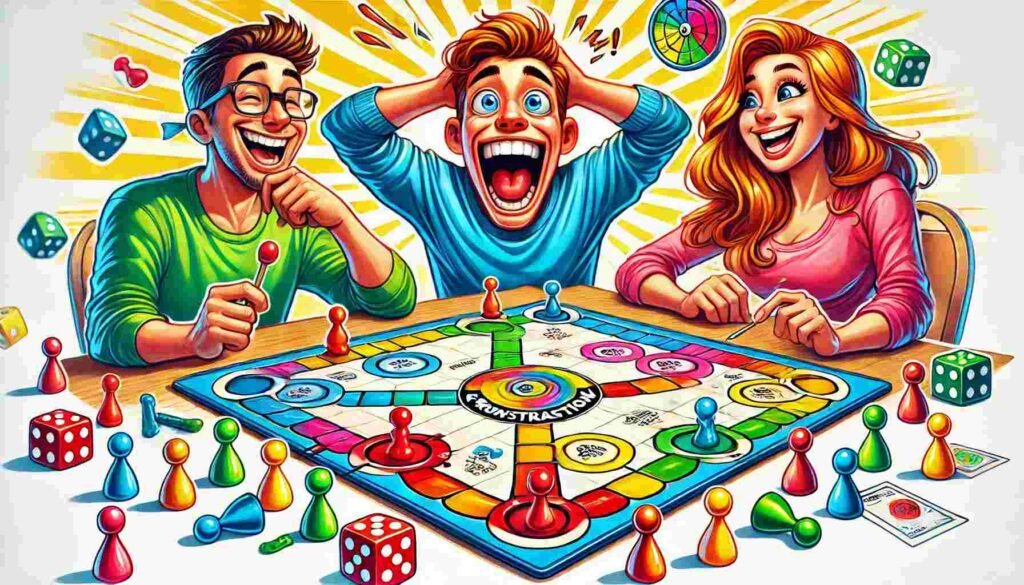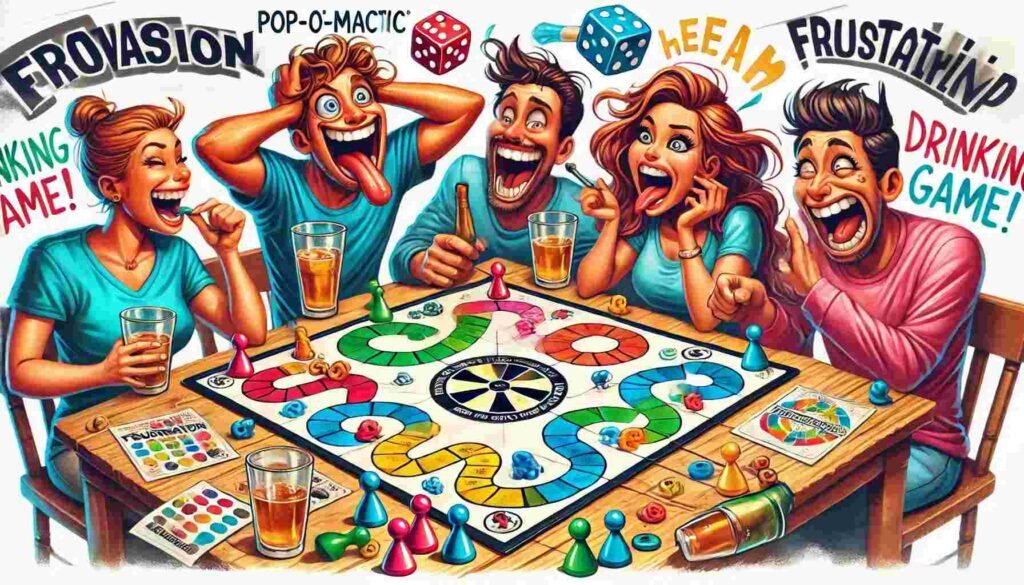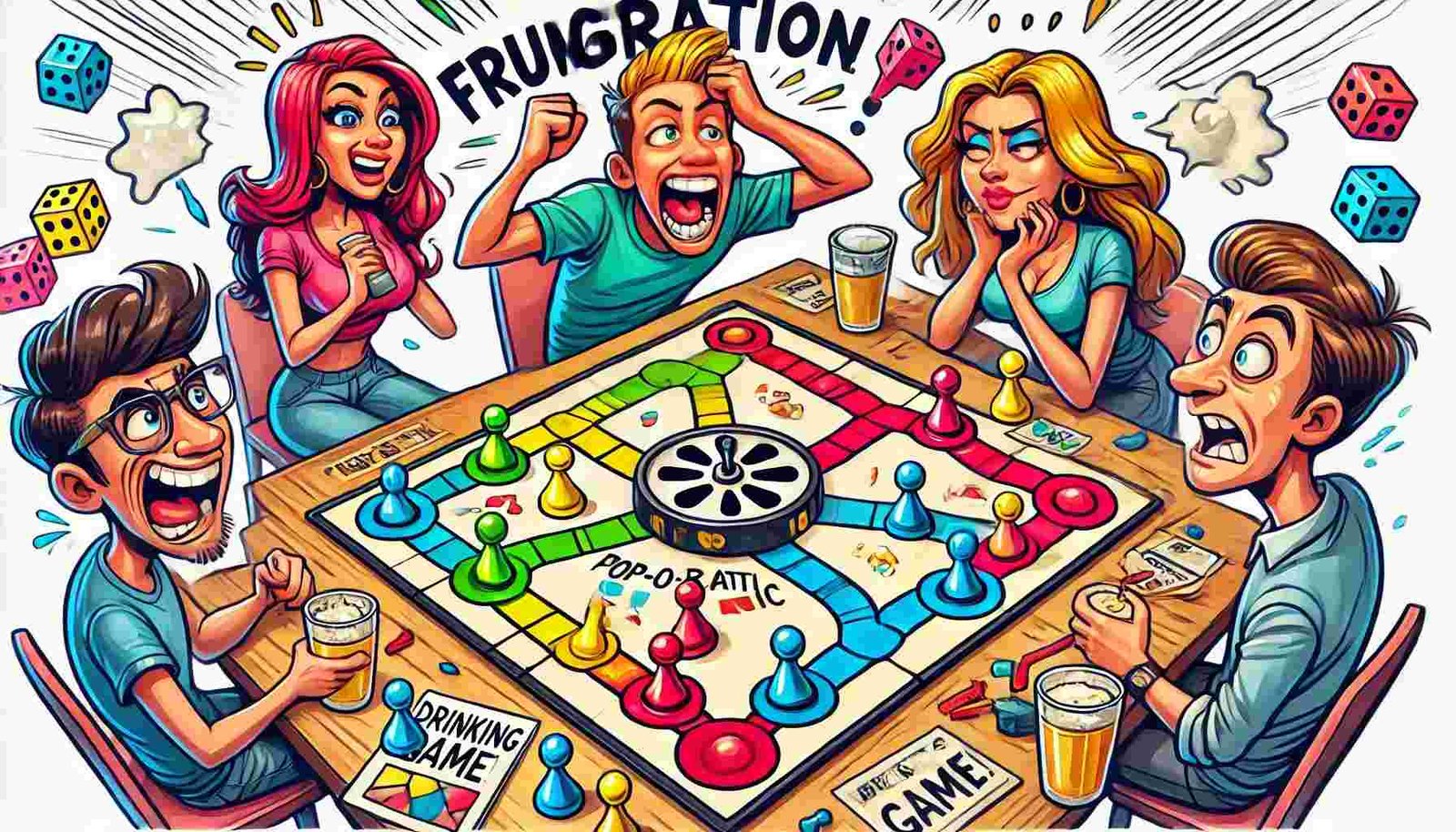Welcome to the world of the Frustration board game, a classic that has caused cheers and groans in equal measure. For those looking to add a little more excitement, we’ve got you covered. This guide not only walks you through the original Frustration rules, but also introduces a fun twist—drinking game rules—that will take your game night to the next level.
Table of Contents
What is the Frustration Board Game?
The Frustration board game, also known as Trouble or Kimble in different parts of the world, is a competitive race game where players move their pawns around the board. The main goal is to get all of your pieces around the board and into the safe “home” zone before anyone else. The game’s standout feature is its Pop-O-Matic dice roller, a transparent bubble that players press to roll the die. This not only adds a unique twist but also keeps the dice from flying off the table!
Originally released by Hasbro, Frustration has stayed popular for decades due to its simple rules and unpredictable gameplay, making it a hit with both kids and adults.

What Are The Original Frustration Board Game Rules?
The frustration board game instructions are simple but filled with strategic twists. Here’s a quick rundown:
- Objective: The goal is to move all your pegs around the board and into your “home” before any other player.
- Starting the Game: Each player must roll a six using the Pop-O-Matic dice roller to get one of their pegs out of the starting area and onto the board.
- Movement: On each turn, press the Pop-O-Matic and move your pieces according to the number rolled. You can only move pieces that are already on the board.
- Capturing Opponents: If you land on a space occupied by an opponent’s piece, their piece is sent back to the start, forcing them to roll a six to re-enter the game.
- Exact Roll to Enter Home: To get a piece into your home, you need an exact roll that matches the number of spaces left to move.
- Winning: The first player to get all their pieces into the home area wins the game.
Frustration Board Game with Drinking Rules
Ready to take Frustration to the next level? With a few fun twists, this classic game can turn into a hilariously entertaining drinking game! Here’s how you can set it up and add some wild drinking rules to make it a party hit.

How to Set Up the Drinking Version
- Gather Your Players: The game works best with 2 to 4 players, just like the original. Each player needs their own set of drinks (beer, cocktails, or shots, depending on your preferred level of intensity).
- Drinking Tokens: Along with your usual pegs, each player places a drink next to their set of pieces. You’ll be drinking based on the movement of your pieces, so keep your glass close!
- Pop-O-Matic in Hand: The iconic Pop-O-Matic dice roller will decide your fate—not only in the game but also with your drinks.
Drinking Rules for Frustration Board Game
Here are more fun and engaging drinking rules to level up your Frustration board game night! This list adds variety, unpredictability, and plenty of reasons to drink responsibly as you play.
- Snake Eyes Sip: If you roll one, take a sip. Rolling one may seem small, but it adds up quickly!
- Shot of Shame: If you’re the last player to get a piece out of the starting zone, take a shot for falling behind. It’s the price you pay for being left at the start.
- Home Stretch Hangover: When you’re three spaces away from your home zone, take two sips every time you miss the exact number needed. The closer you are, the more frustrating it gets!
- Backfire Shot: When you send an opponent’s piece back to the start, the opponent must take a half drink.
- Doubles Trouble: If you roll the same number on two consecutive turns, take two sips. If it happens three times in a row, take a shot.
- Bounce Back Sip: When you roll a six to bring a piece back from the start, everyone else must take a sip in honor of your comeback.
Special Rules:
- Double or Nothing: If you roll two consecutive sixes, choose anyone to drink. If you roll another six, you must finish your drink with your non-dominant hand like the Buffalo drinking game.
- Frustration Frenzy: If you roll three sixes in a row, declare a Frustration Frenzy: all players must chug half their drink.
With these drinking rules, Frustration turns into a party game full of laughs, drama, and plenty of drinks. Just remember to play responsibly and know your limits—don’t let the frustration get the better of you!
Sorry! vs. Frustration: Key Differences
If you’re a fan of Frustration, the Sorry Board Game is a must-try! While Sorry! and Frustration share similar roots with race-to-the-finish gameplay, each game has unique twists that set them apart.
Movement Mechanic:
- Sorry: Uses cards to dictate moves, allowing players to strategize with each draw.
- Frustration: Relies on a Pop-O-Matic die roller, making each turn completely chance-based.
Player Interaction:
- Sorry: Players can use the “Sorry!” card to strategically bump opponents back to Start.
- Frustration: Bumping opponents back is based on dice rolls, adding unpredictability and quick-paced play.
Game Style:
- Sorry: Slightly more strategy-focused, as players can decide when to play offensive or defensive moves.
- Frustration: Emphasizes pure chance, offering fast-paced, easy-to-learn gameplay.
Overall Experience:
- Sorry: Best for those who enjoy a mix of luck and planning.
- Frustration: Ideal for fans of high-energy, chance-driven fun suitable for all ages.
FAQs for Frustration Board Game
What is the Pop-O-Matic in Frustration?
The Pop-O-Matic is a plastic dome in the center of the board that houses the dice. Players press it to roll the dice, adding a fun, interactive element to the game. It keeps the dice contained and creates suspense with each pop.
What happens if you land on another player’s piece?
When you land on another player’s piece, that player’s piece is sent back to their starting position, and they’ll have to roll a six again to get it back on the board. This is a crucial move to slow down your opponents!
Why is the board game called Frustration?
The board game Frustration gets its name from the emotional experience it often creates during gameplay.Players must wait for exact dice rolls to move their pieces into the “home” zone, which can be frustrating, especially when opponents send your pieces back to the start. The name highlights the game’s unpredictable and challenging nature, making victory feel even more rewarding!
How many players can play frustration?
Frustration is designed for 2 to 4 players, making it ideal for both small groups and family gatherings. For 2 players: The game is more tactical, with more space to move around the board. For 4 players: It becomes much more intense and chaotic, with a higher chance of capturing opponents’ pieces and getting sent back to the start.
